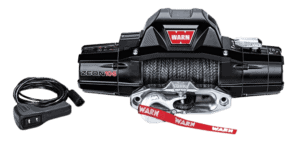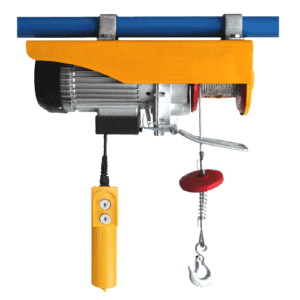Last Updated on June 28, 2021
Do you remember the machinery that is used to pull objects upwards? No, we are not just talking about the winch.
Though many struggles with winch and hoist concepts, many distinctive features make each of them stand out.
Many industrialist users in the enterprise tend to think that they have the same function as they share the indistinguishable structural composition. Still, if one looks closely, one would see that the function of these parts is different.
In this article, we will share with you one of the basic concepts of what winch and hoist are and how diverse they are based on their functionality.
Quick Navigation
The General Concept of Winch and Hoist
Before we move onto the subject of the difference between hoist and winch, we will try to clear out the general concept about what winch and hoist are.
Winch

Generally, the winch is a device that is used to wind up a cable or rope to any kind of appliance inwards or outwards so that tension can be created among the system to generate force.
This force becomes the point of emphasis that pulls an object upwards. We are sure that you know about the fact that winch has many aspects that bring about the functionality of the machinery.
But did you know that the winch drum, one of the parts of the machinery, is powered by either air, electricity, or hydraulic energy? The drums are constructed using fabricated steels, which lengthen the longevity of the machinery.
Designed specifically to maintain the heavy load, the structural integrity of the machine is heavily influenced by the dimple winch without the complexities.
A simple winch has only two things that bring about its composition. A rope and drum or barrel which has a cable wound roped around it makes the manual version of the Winch.
However, this particular application has long been evaded due to the incorporation of technological advancement in the industrial world. The simple machine turned into a piece of art in the industrial era.
From the simple winch to the industrial winches, the essence of the machine has been retained by its functionality.
By the way, we have reviewed different types of winches such as:
- Heavy duty pickup truck winches
- Top 10 Car hauler/ trailer winches
- Cheap electric winches
- Good quality hand operated winches
- High quality Portable electric winches
- Warn Axon vs Warn Vrx: Which One Should You Buy
Hoist

Have you ever been to a construction site? If you have, then try to remember the equipment that was used to lift heavy construction materials. Yes, that is what the hoist is.
The hoist is best suited to lift heavy industrial and construction material compared to the Winch as the structure of the machinery permits it to disperse balance.
The distribution of balance to each portion of the object makes it easier for the hoist to lift or lower massive items.
Having only two parts that make the machine functional, the hoist’s best thing is that it is easily operable as one can utilize it using manual power or motored power.
The manual hoists can be operated using ropes or chains; meanwhile, the powered hoist can be driven using electric, hydraulic, or pneumatic motors.
The manual hoists, which include the generic hand-cranked or levered parts, were vanquished by the electric chain hoists to complete tasks in the industrial endeavors.
By plugging into any electrical outlet, the Electrical version of the manual hoist replaced the manual one quickly.
Another version of the hoist to suit the purpose of an industry that works with the flammable, dusty, dirty environment, the air chain made its debut.
The Difference between Winch and Hoist
Do you know why, even after doing almost the same task, the winch and hoist are different from one another? We all know how you can think that winch and hoist are the same, given the fact that both of them share the same task description. But certain characteristics set them apart from one another.
| Winch | Hoist |
| It uses dynamic brakes in its gear system to function. | It uses physical/mechanical brakes to function. |
| The performance of the winch is relatively stable. | The performance of the hoist is unstable. |
| It offers a significant amount of resistance. | The amount of resistance offered by the hoist is less. |
| Winch mainly follows electric or pneumatic installation. | Hoist follows a mechanical system installation. |
| The distribution of balance in the winch is complex. | The distribution of balance in hoist is comparatively smooth to take the tasks of shifting goods quickly. |
| Winch can take an excessive amount of loads. | Hoists have load-limiting switches, so it can take only a certain amount of load. |
| The winch is constructed in a way so that it can wind up heavyweight horizontally over a level surface. | The hoist is constructed in a way to lift heavy weights vertically from a steeper surface. The steep decline can be greater than 45 degrees. |
Tips to Maintain Hoist and Winch
No matter which one you select, to maintain the piece of machinery’s integrity, regular maintenance is needed. Generally, the machinery comes with the manufacturer’s guidance, which you should follow thoroughly. However, if you don’t have one, follow the ones that are mentioned here.
- Ensure that you inspect the winch after each use to secure the quality of the role.
- Always clean the winch and the remote control of the machinery.
- While utilizing a vehicle-mounted winch, ensure that the vehicle battery and cables are intact as using them for a long time can create a strain on them.
Conclusion
No matter which one you select, make sure that you educate yourself. Understand your requirement and then engage with the buyer. Only then will you be able to get the right piece of machinery suited to your purpose.


I’m Daniel Galbreath, founder of OffRoadersWorld.
I spend my spare time writing on this website, OffRoaders World. I share my thoughts and reviews on different types of gears, share tips sometimes. This website is specially created and regularly updated basically to help other folks like me when I started to solve the various problems they face, specially when they go off-roading.
